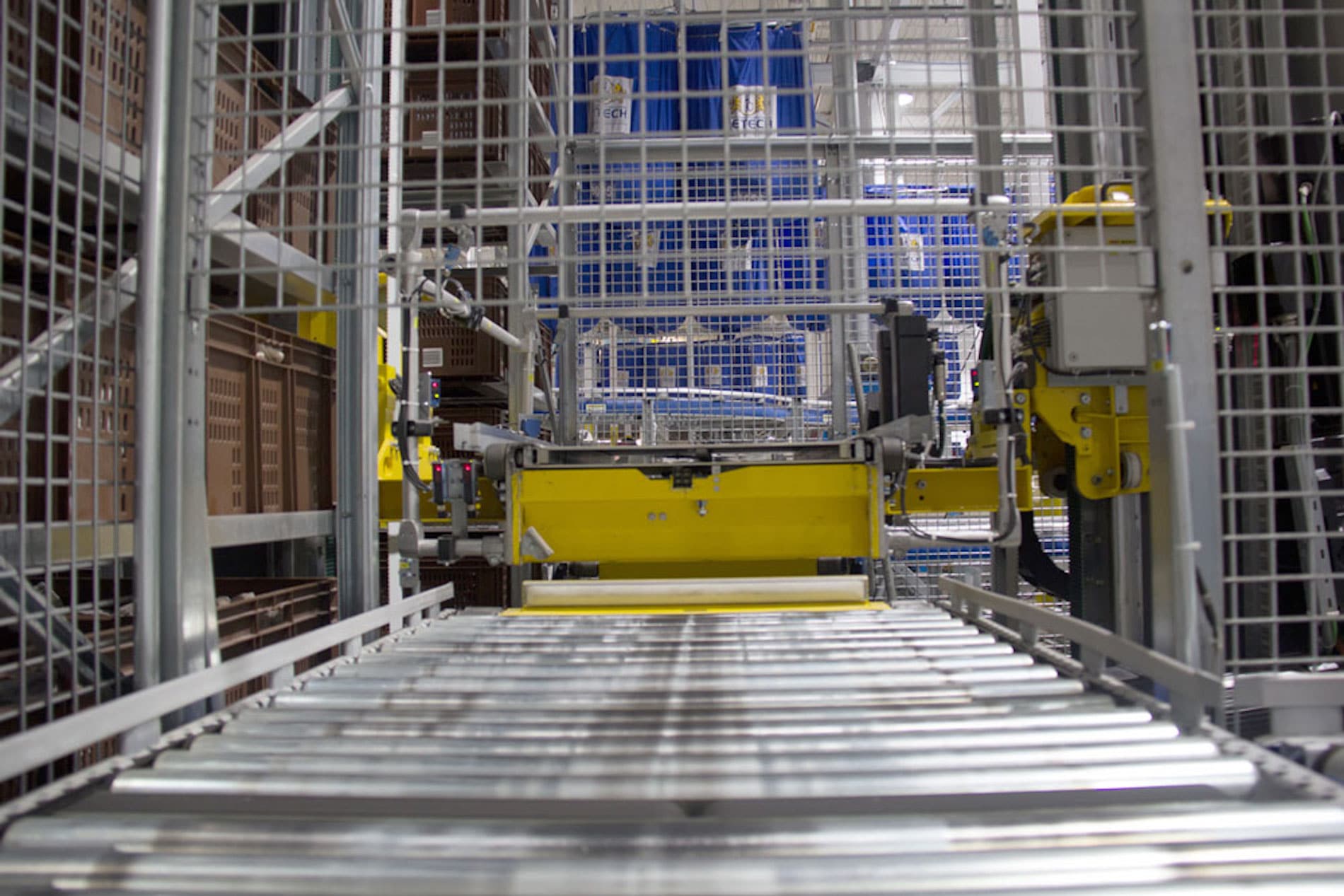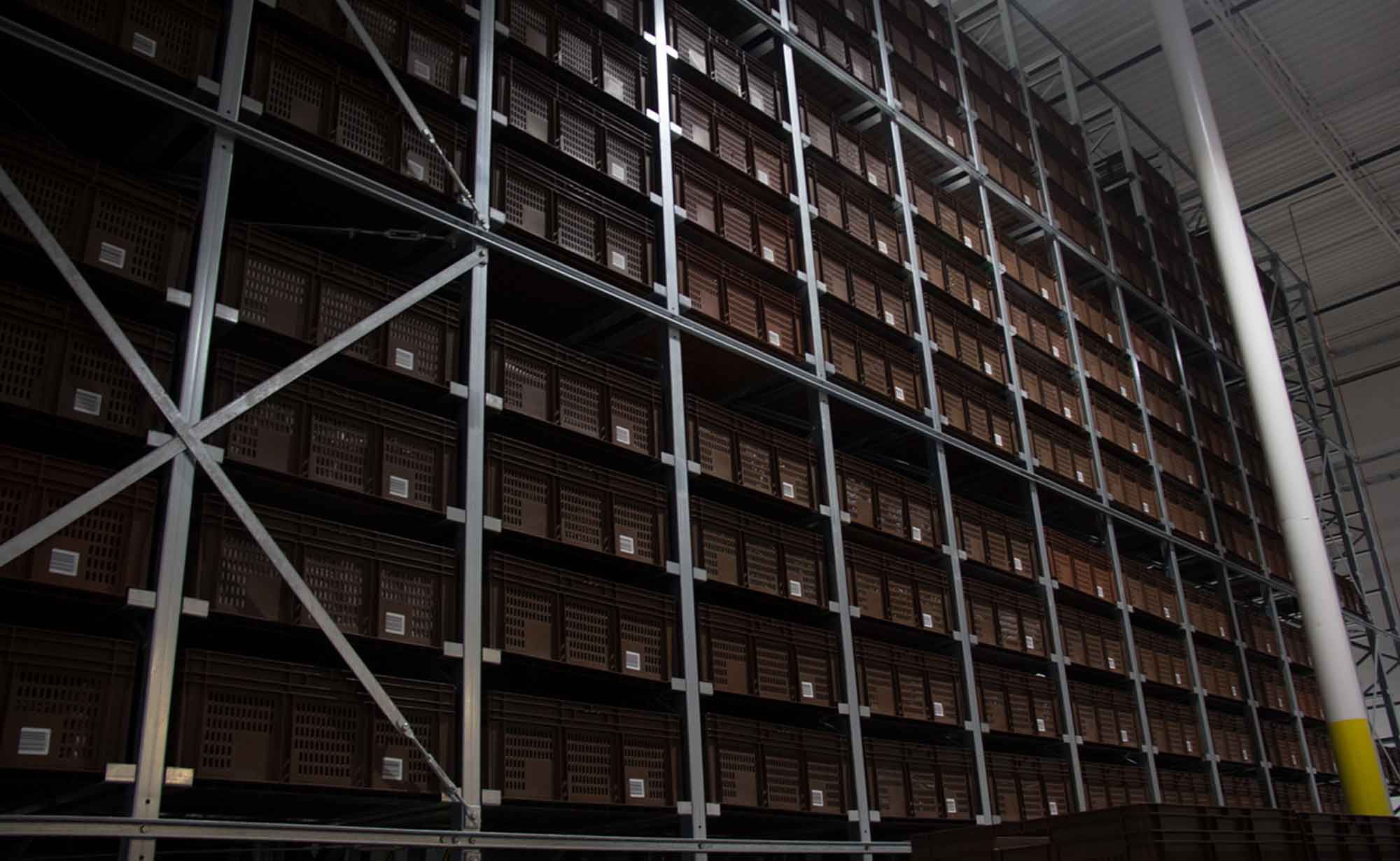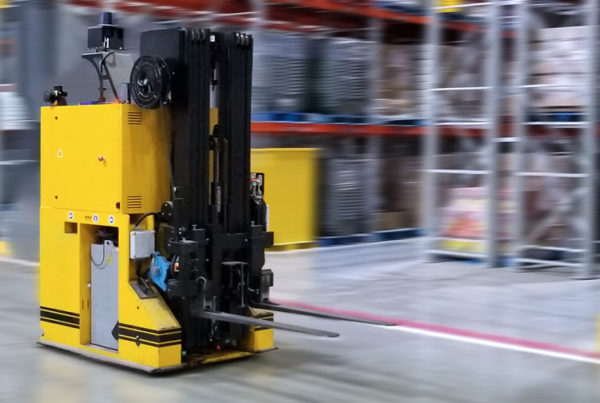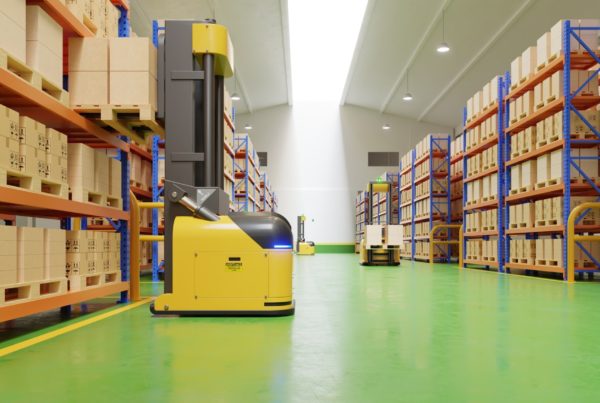What is an Automated Storage and Retrieval System?
At its most basic, an Automated Storage and Retrieval System (abbreviated AS/RS or ASRS) consists of an automated Storage and Retrieval Machine (SRM), a storage area, and computer controllers that both archive product data and guide the system.
AS/RSs date back to the 1960’s and were designed for large and heavy loads. The technology then evolved in two ways. First, it became possible to handle smaller, more delicate, and oddly shaped items. Second, it became affordable to store vast amounts of data – including the size, weight, and location of many thousands of pieces.
AS/RSs can be relatively small and interact with a subset of items within a larger warehouse environment. Or they can serve as the primary means of storing and retrieving product in even the largest material handling processes. Depending on the system, AS/RSs can handle loads consisting of small parts or large, multi-ton units.
Until recently, AS/RSs were prohibitively expensive for all but the largest, most efficient distributors and manufacturers. However, advances in technology have increased their modularity and scalability, and made them more practical smaller organizations. Indications that your organization might benefit from an AS/RS include:
- The need for increased efficiency,
- Difficulty finding and retaining labor for repetitive tasks,
- Space shortages to the point that an expansion or relocation is being considered, or
- Inadequate inventory controls.
If your business suffers from any of these issues, then an AS/RS is one option to consider. However, whether or not they are the best option is a difficult question to answer. At PeakLogix, our mission is to find the right solution for your business by first learning your needs, goals, and processes, and then discussing the advantages and disadvantages of all the possible solutions with your management team.
Understanding the needs and requirements
An AS/RS offers many benefits but, before we get into those, we want to be realistic about some of their requirements and disadvantages.
The first requirement to consider is predictability. These systems work best in operations that are regular and repetitive – pulling trays, bins, or pallets from storage to an access point. If the products or materials change even from season to season, it can be difficult for AS/RSs to be adjusted in a cost-effective way.
Other requirements include training and maintenance. Operators need to be trained to work with these systems safely, and the leadership team will need to be prepared for the resistance to change that’s likely to creep up at every affected level. At the same time, regular maintenance – either from on-site staff or a service provider – has to be included as part of the business plan.
Finally, and perhaps most obviously, is the relatively high up-front cost. The plan is always for the benefits in efficiency to recoup these costs – but that’s only true when the right system is chosen and implemented effectively.
To minimize the risks associated with this investment, PeakLogix has an intensive discovery process in which we learn a business’s processes and capabilities, and can help select the right automation to streamline operations.
The benefits of integrating the right AS/RS
Labor
Labor costs consume 50% of a typical distribution center’s operational budget and, on average, 30% of that is temporary labor. At the same time, the tight labor market has wages on the rise.
In a person-to-goods system, the picking process is a warehouse’s biggest time sink, as operators travel back and forth hunting for items. Being more efficient in that process is critical.
When properly implemented, AS/RSs increase labor productivity by as much as 85%. Moreover, while there are still ongoing costs such as maintenance, they are easier to predict and budget for than the costs of overtime pay, temporary employees, or labor shortages.
Storage density
Among the most cost-effective changes a warehouse can make is increasing storage density. Packing the same quantity of goods into less space creates important opportunities – perhaps to store more SKUs, use that floorspace for other critical functions, or simply occupy less space.
At the same time, you can decrease travel time when putting into and picking from more densely packed spaces – an important factor whether your operations are manual or automated.
AS/RSs are the densest inventory storage option. They both enable pieces to be packed more tightly – sometimes as split cases or totes, and sometimes in narrow aisle racking – and use the entire cubic space of a warehouse.
Improved Safety and Ergonomics
A 2012 article published by EHSToday linked most of the injuries in warehousing to poor ergonomics – such as high applied force, awkward positioning, short cycle times, and infrequent breaks.
AS/RSs can help all of these issues. Heavy loads can either be lifted by automation or made lighter with lift-assist technologies. The repetitive motions of picking and packaging can be made more ergonomic by delivering product in the operator’s golden zone. Bottlenecks can be eliminated, and periods of rest programmed into the system instead of being unpredictable artifacts of upstream problems.
In 2018, the Bureau of Labor Statistics found that Warehousing and Storage had a recordable rate of injuries of 5.1%. This is against a national average of only 2.8% – numbers that are at best flat for the industry over the previous year. This is at the same time that automation – a technology that can improve workplace safety – has become more prevalent in the industry.
One reason for this incongruity is the rapid change in the industry. Next-day and even same-day delivery, coupled with the sheer quantity of goods moving through a typical warehouse, increase the risks for injury faster than safe work habits can be developed.
Another reason for the relatively high recordable rate in the industry is human error, either in implementation or in later management. Systems can be poorly designed, either in how operators interact with them physically, or in the frequency with which operators are forced to perform repetitive tasks. Well-designed systems use automation to stage, buffer, and deliver product to operators in a timely fashion. It is possible, however, to focus too much on delivering numbers, driving the system ever faster without regard to employee risk.
While improved efficiency is probably the greatest selling point for automation, where human operators are concerned, their safety and comfort still have to be considered.
At PeakLogix, the health and wellbeing of the operators is one of our biggest drivers. In installation after installation, operators find that their quality of life improves with the proper implementation of automation. We strive to improve your business’s efficiency and make it more profitable, but not at the expense of its employees. Proper implementation of these technologies enables them to protect the workforce and even improve their quality of life, while at the same time improving the business’ profitability.
Efficiency, accuracy, and damages
In manual systems, about half of all labor hours are spent traveling to and from a pick face. Even when items are kept in a relatively tight space, if the picker has to walk up and down an aisle hunting for items, the entire system is inefficient. Automating that process will improve efficiency and throughput, and reduce labor costs.
At the same time, human error is the number-one cause of mistakes in the fulfillment industry. Especially in tasks that require perfection, such as manually entering addresses or SKUs, humans will make mistakes that computers and robots will not. Even a small item sent to the wrong department can cause slowdowns, bottlenecks, and even shutdowns in the fulfillment process while the error is first understood and then resolved. Items misplaced during put-away can become even more problematic, as entire teams of people have to search complex storage areas.
AS/RSs increase accuracy to more than 99.99%, eliminating issues of misplaced merchandise, reducing waste, and increasing throughput. Moreover, AS/RSs won’t turn down the wrong aisle, stop at the wrong bin, or slow to read numbers or signs.
Because these systems are so precise, damages to both product and infrastructure are all but eliminated. Robots carrying heavy loads will not run into walls, racking, or – most importantly – personnel. And end-effectors have become both sensitive and versatile enough to handle even the most delicate, oddly shaped, or difficult to grasp items.
Types of AS/RSs
Unit Load AS/RS
Unit-load AS/RSs store and retrieve loads of as much as 5,500 lbs. Most commonly these are pallets, but systems can be specialized to handle furniture, carpeting, or other heavy or oddly shaped items.
These systems can reach as tall as 100 feet – more than enough for the typical warehouse. They are usually narrowly spaced, specially designed pallet racking. The storage and retrieval machine is made up of a mast, carriage, and load-handler, and travels between the racking in two dimensions.
At the storage location, the load-handler slides under the pallet and pulls it into the carriage. The SRM then brings the load to an access point for an operator.
Unit load AS/RSs are usually configured with one SRM per aisle. However, multiple SRMs can be assigned to a single aisle in high-throughput systems, or a single SRM can be assigned to multiple aisles in slower systems.
Mini-load AS/RS
Mini-load AS/RSs are used to store items of less than 100 lbs. They function like self-contained unit-load AS/RSs. Like unit-loaders, mini-loaders are composed of two aisles of narrowly spaced racking, between which an SRM move in two dimensions.
One benefit to mini-loaders is their modularity. They can be between 10 and 40 feet tall, 50 to 300 feet long, and installed as a single aisle or multiple aisles, depending on space and requirements.
As well as being perfectly suited to order fulfillment, mini-loaders are often used for small part storage and retrieval in manufacturing, and are even used by the government and universities for books and other documents.
Depending on their use, they can achieve rates of as much as 100 cases per hour per aisle.
Shuttle/bot-based AS/RS
For businesses or applications with low ceilings or other space restrictions – cold storage, for example – shuttle-based AS/RSs offer benefits comparable to crane-based AS/RSs, but in a more flexible arrangement.
There are many kinds of shuttle-based systems – the one feature common to all of them is that the SRM is a shuttle or small robot. When an item is requested, this shuttle moves to its location. In some systems, the shuttle moves from the workstation to the racking. It then travels through the racking (with, for example, vertical reciprocating conveyors) to retrieve the item, and then returns to the workstation. Other systems use conveyors to move items from the racking to the workstation.
Shuttle-based AS/RSs are highly flexible, suitable for both first-in/first-out or last-in/first-out configurations, and deep or shallow-lane storage.
Carousel-based AS/RSs
Carousel-based AS/RSs come in two basic layouts – horizontal and vertical. Both systems use bins to both store and move inventory. The bins are housed in shelves, which are themselves on tracks.
In a horizontal system, the tracks move the shelves horizontally. It’s a bit like a lazy Susan or a display rack of postcards or sunglasses – except instead of a single pivot point rotating a few items, the tracks can be scores of feet long.
Vertical systems operate like Ferris wheels; columns of trays or bins move vertically by a chain attached to a motor. Operators stand at an access point behind a safety barrier. While their basic premise is half-a-century old, vertical carousels are such a reliable, flexible storage and retrieval option that, instead of being relegated to obsolescence, they have been consistently improved upon over the years.
Both vertical and horizontal carousels offer compact designs that save up to 75% of the floor space over traditional racking systems. Items are delivered to operators at an ergonomic height and, when used in conjunction with technologies such as pick-to-light, offer accuracy increases of up to 99.99%.
Vertical lift module
Vertical lift modules (VLMs) are enclosed systems consisting of two columns of shelves. Between these columns, an inserter/extractor moves to store and retrieve product.
Items are brought to an ergonomic pick window on trays. One innovation with VLMs is that, as items are returned to storage, their height is scanned. The system then optimizes the height of the shelves, and stores the item so as to maximize storage density.
Combined with pick-to-light technology, VLMs can increase productivity and reach accuracy levels of 99.9%. Compared to traditional racking, they save up to 85% of the floor space by packing items more densely, and by using the cubic space of the warehouse in a floor-to-ceiling installation.
As with all AS/RS systems, VLMs are goods-to-person, eliminating travel time for operators; VLMs can increase productivity by up to 66%.
VLMs are highly modular, and can be installed as single units or in multiple units that create a picking zone. In this set up, while an operator picks from one VLM, another is retrieving and presenting a second item. This “round robin” manner of picking increases throughput by decreasing wait time.
Micro-load stocker
Micro-load stockers are functionally similar to vertical lift modules. They are self-contained, store product densely in bins that are retrieved and stored by an inserter/extractor, and deliver product to an operator at a pick face.
Internally, micro-load stockers operate a bit differently than VLMs. There are different systems of micro-load stockers, and each model stores and retrieves items in a distinct way. One difference operators will see between VLMs and micro-load stockers is at the pick face. Where a VLM’s pick face is window-like, a micro-load stocker often uses a conveyor to bring a queue of items.
Micro-load stockers are often integrated with other AS/RS systems, serving to buffer and stage items, reducing the need for conveyors and increasing available floor space.
A powerful tool, one option among many
Automated storage and retrieval systems store items densely, retrieve them efficiently and add inventory controls to warehouse environments.
Formerly, only the most elite companies could afford AS/RS technologies. However, with their increasing modularity and scalability, coupled with improvements in technology, many businesses today would benefit from the inclusion of these systems.
However, while these systems offer many benefits, they aren’t always the right fit. Some businesses could benefit more from some other automated system, such as pick-to-voice or automated guided vehicles.
Knowing which system is right for your business is not easy. Discovering which is right for your business, however, is something PeakLogix takes very seriously. We aren’t in the business of selling white elephants. We are in the business of forming partnerships and helping our partners by learning their goals and needs, and then customizing the best solution to meet them.
Want to know if integrating an AS/RS is right for your operations? Contact us to talk details and strategies.
Increased utilization and capacity for nutritional supplement manufacturer
The client was able to increase its realized capacity by more than 60%, using 614 of 768 available pallet positions or a utilization rate of nearly 80%. In addition, the client is benefiting from a clear receiving dock, which facilitates their ability to unload the additional inventory that can now be ordered more efficiently.






